 15 years is a long time but I can vividly remember Christmas 1998 as the year when I bought my first mobile phone at the ripe age of 16, the Motorola AM3180; there it is over there on the right - what a beauty! Long before the introduction of touch screen smartphone devices the AM3180 boasted a Monochrome STN Display, no games, no camera and although it was one of the first phones to have a built-in address book, you still had to type the recipient’s telephone number each time you sent a text message! Nevertheless I was over the moon with my AM3180 purchase at the time - how things have changed!
15 years is a long time but I can vividly remember Christmas 1998 as the year when I bought my first mobile phone at the ripe age of 16, the Motorola AM3180; there it is over there on the right - what a beauty! Long before the introduction of touch screen smartphone devices the AM3180 boasted a Monochrome STN Display, no games, no camera and although it was one of the first phones to have a built-in address book, you still had to type the recipient’s telephone number each time you sent a text message! Nevertheless I was over the moon with my AM3180 purchase at the time - how things have changed!
Since 1998 mobile industry has skyrocketed at a phenomenal rate and mobile technology, both handset and network, have evolved extraordinarily since the days of my trusty old Motorola AM3180. Needless to say mobile phones now play a key role in this age of digital marketing serving as a fundamental marketing tool.
Whilst many large-scale organisations have taken to mobile, in my experience 2013 has been a learning curve for many SME business owners and marketing executives as they begin to delve into their mobile data and begin to truly understand their mobile audience.
The Mobile Marketing Revolution
In my opinion (I believe most, if not all, digital marketers would agree) the need for mobile search visibility should now play an integral role in digital marketing strategy for any business, be it a global brand or a local start-up business.
Over the past 12 months we’ve begun to see traffic via mobile devices replace traffic via desktop computers. This trend is expected to continue throughout 2014 with many people predicting that mobile usage will fully surpass desktop usage.
But with all the hype around mobile I often see instances of businesses frantically trying to develop mobile websites to ensure they can say “I have a mobile site” but without truly considering the long-term objectives of their business and the long term requirements of their users.
We live in a multi-screen world performing queries across multiple platforms in different situations according our needs as the user; therefore understanding what it is the user wants and how to market products and/or services towards the user is the first hurdle. With 2014 on the horizon perhaps it’s time to set a New Year’s resolution – understand your mobile audience.
Understanding Mobile Consumer Intent
It’s been heavily documented that the intent of mobile searchers is often significantly different to the intent of desktop searchers, with local intent high on the list of priorities for mobile searchers who are often on the go looking for local and/or real-time information.
In November 2012 Ed Parsons, Google Geospatial Technologist, gave this fascinating keynote session at Google PinPoint London 2012 stating that 1 in 3 searches are about places.
Whilst the video of Ed Parsons keynote session is not specifically mobile related it provides fantastic insight into geospatial technology and Google’s views on location data for business. Google have invested a lot of time and effort into the development of geospatial technology understanding what are people searching for and how geography can potentially help. With the growth of mobile usage products such as Google Maps have become increasingly important for mobile search and with the introduction of Knowledge Graph in early 2012 Google can serve location data quickly and accurately in a user friendly manner.
Understanding user intent and the resulting action is the foundation of any mobile marketing strategy. In March 2013 Google produced a study in partnership with Nielsen analysing over 6k mobile searches and the associated actions.
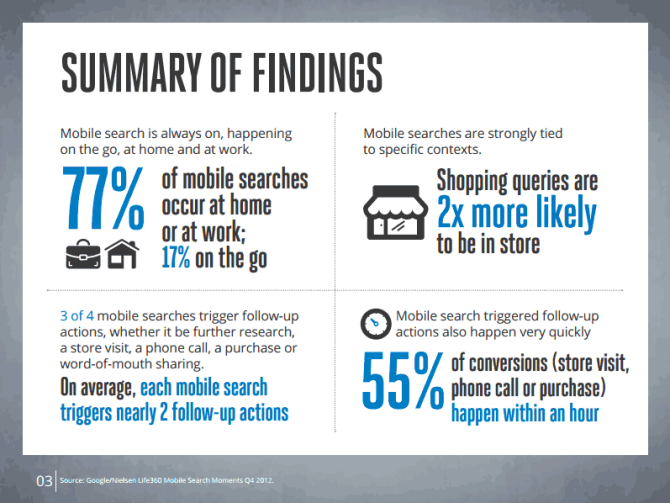
The study explores measurable connections between mobile search queries and conversions that they drive, be it online or offline, stating that 3 out of every 4 mobile searches trigger follow-up actions.
Understanding the actions as a result of a mobile search is integral to any business seeking to cater for mobile users. As mentioned previously mobile user intent often differs significantly to desktop user intent so user actions inevitably differ too. As an example, in my experience businesses often expect the conversion path for mobile to mirror desktop which is seldom the case. According to Google 45% of all mobile searches are conducted as part of the decision making process therefore the conversion journey is a significantly different process.
Mobile search drives multi-channel conversions be it online or offline with 73% of mobile searchers triggering additional actions:
- 36% continue research
- 25% visit a retailer website
- 18% share information
- 17% make a purchase
- 17% visit a store or service location
- 7% call a business
For any business investigating mobile as part of their digital marketing strategy for 2014 and beyond understanding how users engage via mobile is essential. To help businesses better understand multi-channel data Google have been working on Universal Analytics which is now available in public beta.
Understanding actions via mobile is only one part of the story. In May 2013 Google’s Our Mobile Planet Think Insights released smartphone research data allowing business to better understand the UK mobile consumer and how we use mobile as part of our daily lives. According to Google 80% of us don’t leave home without our mobile devices!

The document (also available for other countries/languages) details some of the key statistics surrounding the use of mobile devices providing valuable insights into the intent of mobile users. Of course this will inevitably vary through different industries but getting to grips with this data is the foundation for those businesses looking to understand the mobile community in 2013 and adapt similar methodology throughout 2014.
Today’s final suggestion for businesses seeking to understand mobile consumer intent is the Google Mobile Playbook. In October 2013 Google released the second edition of the playbook providing all the latest best practices and mobile strategies to help businesses succeed with mobile.
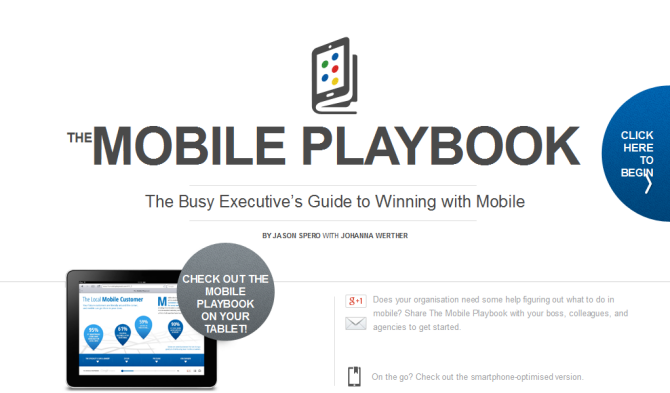
Written by Google’s Head of Global Mobile Sales & Strategy Jason Spero, the document walks businesses through 5 crucial mobile questions that every business executive should be asking today. These include:
- How does mobile change our value proposition?
- How does mobile impact our digital destinations?
- Is our organisation adapting to mobile?
- How should our marketing adapt to mobile?
- How can we connect with our tablet audience?
Have you asked yourself these or similar questions? Any business seeking to dive into the mobile marketing revolution in 2014 should take 15 minutes or so to read through the playbook, or if you’re short of time here’s the action checklist:
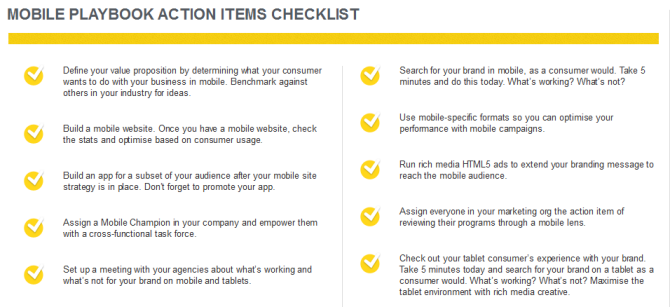
By analysing the research cited above you should now have a good understanding of the intent of mobile users and understand, to a certain extent at least, how mobile users are likely to engage. Truly understanding your mobile audience is an essential factor for any business reaching out to the mobile community, but what are the technical optimisation considerations for mobile?
Achieving Sub-Second Page Load Times
Do you know how fast your mobile website is? More to the point, do you care how fast your mobile website is? Well Google do, so if part of your 2014 digital marketing strategy is indeed increased mobile organic search visibility then speed should definitely be high on the list of mobile considerations.
To Google speed matters so they are devoted to making the web faster, in turn pushing much of the responsibility back at the businesses responsible for serving the mobile websites.
It was way back in 2010 when Google first announced that site speed would be one of the many signals for organic search rankings, so it was not entirely unexpected that Google recently pushed the notion that they will algorithmically reward websites which achieve the goal of page load times in sub-one second.
Google research highlights that, at present, the average mobile page load speed is ~7 seconds.
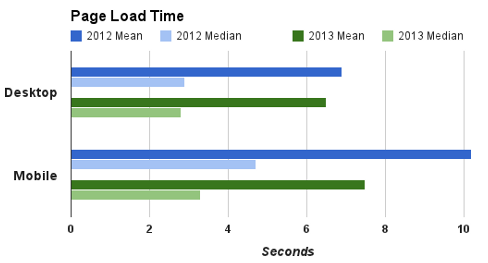
To combat this and minimise page load times Google suggest a change to the way in which websites render, suggesting that webmasters optimise the critical rendering path to deliver instant mobile websites.
In essence, Google propose that mobile sites should render some of the content above the fold in a maximum time of 1 second, showing this to the user whilst rendering and loading the remaining HTML, JavaScript, CSS etc in the background. Google suggest that:
We can achieve sub-second rendering of the above-the-fold content on mobile networks by applying the following best practice
- Server must render the response (< 200 ms)
- Number of redirects should be minimized
- Number of roundtrips to first render should be minimized
- Avoid external blocking JavaScript and CSS in above-the-fold content
- Reserve time for browser layout and rendering (200 ms)
- Optimize JavaScript execution and rendering time
To support the concept of sub-second load times Google added new mobile guidelines including how to adapt to mobile networks with high latency and expanding on the aforementioned bullet points.
It’s important to note that Google are not stating that the entire webpage must load in <1s. Instead they are suggesting use of a combination of techniques to render key content in <1s in order to engage the user in minimal time.
If applied correctly, adherence to these factors could potentially give a mobile website a significant competitive edge from an SEO perspective over competitor websites not utilising such techniques. Exactly how much weighting Google are going to apply to the sub-second rule remains to be seen, but as a business aiming to achieve higher mobile search visibility in 2014 achieving sub-second page load times should be a key objective.
Best Practice Mobile Optimisation
Sub-second load time is a great mission objective for 2014 but what other targets can you set yourself/your business in 2014 to assist in mobile search growth? Well let’s start by ensuring your website complies with fundamental best practice requirements set by Google.
In addition to sub-second speed requirements there are various best practice techniques which webmasters can utilise to ensure their mobile website is compliant. Many of these recommendations have been around for a while now but in my experience often get overlooked.
For example, Google have a whole set of speed tutorials to help webmaster leverage techniques such:
- File compression
- Browser paint events
- CSS and JavaScript declaration
- HTTP caching
- Minimizing browser reflow
- Code optimisation
- Graphic optimisation
- Prefetching resources
Similarly the Google Developers smartphone-optimised websites section details various techniques for mobile optimisation, from user-agent detection and redirection to caching and compression.
Although I clearly talk a lot about Google compliance many of these factors also apply to other search engines such as Bing and Yahoo. Bing have their own mobile optimisation documentation so it’s definitely worth bearing in mind that these types of practices are not just for Google’s benefit; ultimately implementation of these factors will enhance the user experience therefore often going some way to satisfying search engines.
That said, some factors can directly affect Google organic search rankings. In June 2013 Google announced fundamental changes to the way in which Google will rank a mobile website detailing some common issues which face webmasters. These include:
- Faulty redirects
- Incorrect handling of Googlebot-Mobile
- Smartphone-only 404 Not Found errors
- Unplayable videos
- App download interstitials
- Irrelevant cross-linking
- and of course…page speed!
The techniques will vary to a certain extent depending on your approach to mobile design. Google favour the approach of responsive design, but there are viable techniques for those adopting a non-responsive design, all of which are detailed within the Google Developers guidelines.
Once you’ve built your website with best practice optimisation techniques in mind you can use Google’s PageSpeed Insights tool to measure the performance of your website via both desktop and mobile simulations.
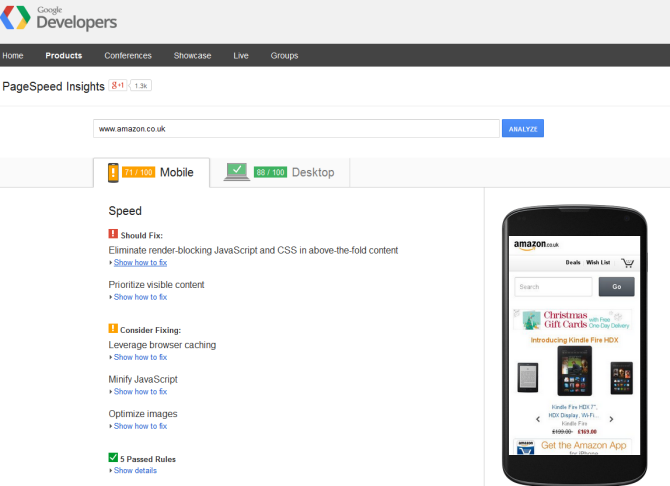
The PageSpeed Insights tool will analyse performance of both mobile and desktop simulations providing a score out of 100 and highlighting areas for improvement.
Surprisingly I still see numerous websites on a daily basis which fail to comply with Google’s guidelines, especially the poor redirection between mobile and desktop websites which, from a user perspective, is extremely frustrating. So as a user I 100% agree with Google’s approach of algorithmically penalising websites which serve a poor user experience.
Yes the implementation of mobile optimisation techniques will inevitably require some development time so yes this will potentially increasing upfront costs, but the results in the long-term are likely to pay dividends for mobile search visibility.
2014 Will Be The Mobile Tipping Point
A lot has changed in the 15 years since I purchased my first ever mobile phone. Mobile users have become dependent on our mobile devices with mobile now an integral part of our lives. Gone are the days of my Motorola AM3180 on which I could scarcely make a telephone call. I’m now using a Galaxy S3 running the Jelly Bean OS with 24 hour access to the Internet with the world at my finger tips giving savvy web marketers a world of marketing opportunity in 2014 and beyond.
But mobile optimisation is about more than simply implementing a few technical website modifications, it’s also about understanding your audience and ensuring your website satisfies the users intention. Understanding what it is that your mobile users expect and understanding how to deliver content in such a manner that caters for their needs is no easy feat but I hope the research which I’ve provided today has helped streamline your thinking.
Many industry experts believe that 2014 will be the tipping point of mobile search where mobile importance finally overshadows desktop. So where 2013 has been a light bulb moment for many businesses beginning to recognise that mobile is the future I envisage 2014 as the year where marketers take the proverbial mobile bull by the horns and get serious about mobile optimisation, utilising techniques to drive a stronger organic search visibility for their business, reaching out to a far wider audience.
But nothing stands still in this day and age so maintaining finger on the pulse will be essential. We’ve seen how mobile behaviour, intent and action have changed over the recent years and we expect this to continue to evolve. Technology such as conversational search is changing search behaviour via mobile devices so keeping a close eye on user behaviour throughout 2014 is critical. Likewise we’ve seen how search engine’s perceptions of mobile websites have changed recently with increased emphasis on factors such as speed and user experience, in some cases algorithmically rewarding websites which comply with these standards.
As technology continues to evolve mobile best practice will continue to evolve so 2014 is not a year to sit back and relax, it’s time to cement your mobile optimisation business strategy.
Related posts:











This is so true, more and more people now are using their phone to browse the net. We should adapt to these changes.
Hi Chris Ainsworth,
I spent almost 15 minutes to read the article or I would say a mobile optimization guide! Really many thanks for sharing deep analysis and infographics. Now I can design a mobile optimization strategy 😉
You’re welcome. Glad you found it useful.